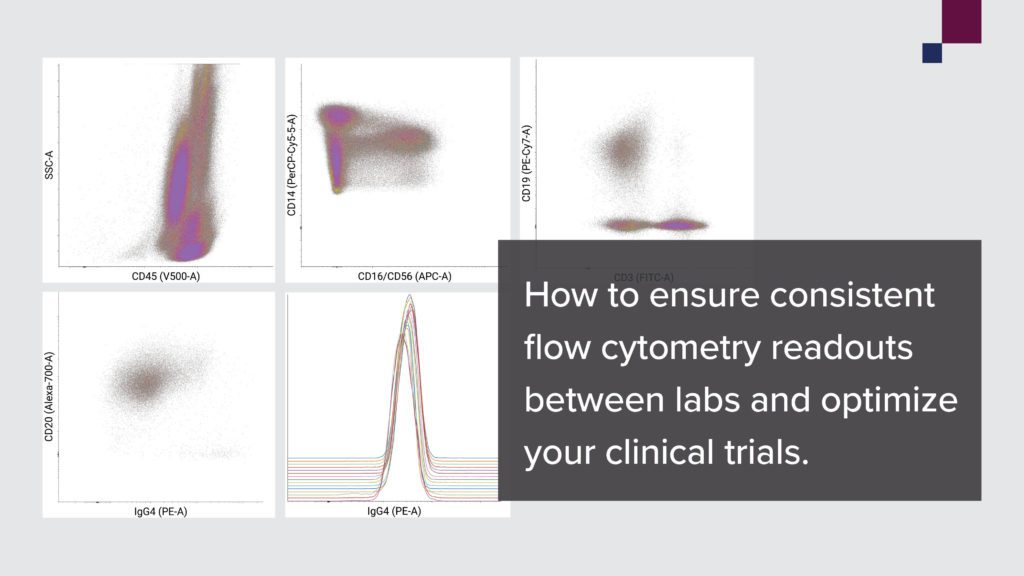September 18, 2024

As more novel therapeutics have entered the drug development pipeline in recent years, flow cytometry has become a core analytical method for characterizing cells, molecules, and biomarkers for therapy evaluation. The technique is especially effective at assessing drugs targeting the immune system, and therefore particularly valuable in the areas of autoimmunity, oncology, and infectious diseases.
However, drug developers face a key challenge when using flow cytometry in clinical research: consistency. Why is this a hurdle, and how can we overcome it?
The challenges of using flow cytometry for clinical trial analysis
Clinical trials are often global in nature, with participants located across multiple sites. While data analysis for such trials is typically centralized, the data itself is produced at many different labs by various operators and instruments. As flow cytometry readouts (mean fluorescence intensity, or MFI) can vary between instruments and sites, it’s difficult and labor-intensive to ensure that they are standardized.
Inter- and intra-site variability of MFI readouts is a major issue for drug developers. Producing standardized measurements across sites is a crucial aspect of conducting successful clinical trials, and therefore key to progressing efficiently along the drug development pipeline.
Our preferred method to help address the issue of inconsistency is to ship reagents from the same lot between sites every time an assay is shared, to provide every lab with the same initial analytical tools. But this is an inefficient and unreliable solution that falls short of facilitating truly consistent analysis, with MFI readouts still potentially differing between stainings and operators.
However, new methods are being tested to bring greater consistency to multi-site flow cytometry, with promising results.
A new way to align flow cytometry instruments from lab to lab
CellCarta recently trialed a new approach to centralizing and standardizing flow cytometry assays across five global sites
A set of CD4 antibodies was stained on polystyrene microbeads (BD™ CompBeads) in fluorescent dyes (fluorochromes) covering the 18 colors of CellCarta’s flow cytometer (a BD LSRFortessa™). These beads were then lyophilized (freeze-dried), after which they were stable at room temperature for 18 months.
The stained and lyophilized beads were then shipped to five sites simultaneously for instrument alignment. Due to the long-term stability of the beads they only had to be shipped once, rather than a new reagent needing to be shipped per round of analysis.
After an initial setup and harmonization process, the beads were used to produce and adjust target values for 12 months (with a key criterion being stability of the MFI signal). Sites were able to create a baseline from which to detect and correct instrument fluctuations and eliminate any differences when these were used for sample analysis. In total, 10+ assays were standardized across five global locations.
The precision and performance of the lyophilized beads was tested over time to assure ongoing MFI stability, with any fluorochromes that were deemed to be underperforming swapped for more stable alternatives.
Fig 1: The assay was successfully shared across all our active sites. Nine fluorescence parameters were aligned using lyophilized BD™ CompBeads, before the assay’s precision was further tested by comparing 14 inter- and intra-site readouts of a reference sample and three healthy donors. To be deemed acceptable, the assays needed at least 80% of the predetermined readouts to have less than 25% CV when comparing reference and receiving laboratories.
The results? More reliable, consistent flow cytometry data across sites
The approach proved robust and reliable for multi-site instrument alignment, harmonizing numerous flow cytometric assays across sites (see Figure 1). Overall, the new approach demonstrated:
- Long-term stability and precision, with comparable performance after one year and across fluorochromes (with all dyes remaining stable for 8 hours and most remaining stable for up to 48 hours post-resuspension)
- Less variability in MFIs, by standardizing the analysis process and reducing any fluctuations arising from operator, instrument, or site differences. Using the transferred assays, 80%+ of readouts showed a coefficient of variation (CV) of less than 30% when comparing reference and receiving laboratories
- Reliable assay transfer and alignment, with more than 10 flow cytometric assays successfully shared and implemented across 5 global site
- Time and cost savings, with reduced shipping and logistics requirements due to the 18-month stability of the lyophilized beads
While achieving reliable, standardized, high-quality flow cytometry data across lab locations can be challenging, this approach demonstrates a potential way to generate consistent data independent of location, instrument, and operator. Such a method could offer peace of mind to drug developers by supporting global clinical trials that require cost-efficient analysis and highly comparable data across geographical sites.
For more details on the alignment project, including its full aims, method, and results, see our research poster Multi-Site Instrument Alignment Using Lyophilized BD™ CompBeads.

Dominic Gagnon M.Sc. SCYM (ASCP)CM is the global flow cytometry Associate director at CellCarta. With a twenty years background in immune monitoring by flow cytometry as well as managing flow core, Dominic guides the team in the harmonization and standardization of cytometers and assays across all sites.
References
[1] Gagnon, D., and Lo, K. (2024) Multi-Site Instrument Alignment Using Lyophilized BDTM CompBeads. Available at: cellcarta.com/science-hub/multi-site-flow-compbeads/
You might also be interested by
CellTalk Blog
B-Cell Populations in Focus: A New Flow Cytometry Assay for Increased Sensitivity in Autoimmune Research
September 19, 2025
Flow Cytometry
More infoCellTalk Blog
Flow Cytometry Applications: Advanced Uses, Benefits, and Limitations
October 17, 2024
Flow Cytometry
More infoCellTalk Blog
Spectral Flow and Mass Cytometry: Select the Right Platform for Your Clinical Study
July 2, 2024
Flow Cytometry
More info